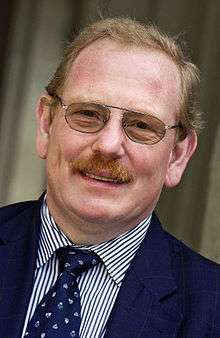Reinhard Genzel
| Reinhard Genzel | |
|---|---|
 | |
| Born |
24 March 1952 Bad Homburg, Germany |
| Nationality | German |
| Alma mater | University of Bonn |
| Known for | infrared and submillimetre astronomy |
| Awards |
Otto Hahn Medal (1980) Balzan Prize (2003) Shaw Prize (2008) Crafoord Prize (2012) Tycho Brahe Prize (2012) Fellow of the Royal Society[1] Harvey Prize (2014) |
| Scientific career | |
| Fields | Astrophysicist |
| Institutions |
Max Planck Institute for Extraterrestrial Physics University of California, Berkeley |
Reinhard Genzel ForMemRS[1] (born 24 March 1952 in Bad Homburg vor der Höhe, Germany) is a German astrophysicist.
Life
Genzel studied physics at the University of Freiburg and the University of Bonn where he did his PhD in 1978[2] and, in the same year, his PhD thesis on radioastronomy at the Max Planck Institute for Radio Astronomy.[2] He then worked at the Harvard-Smithsonian Center for Astrophysics in Cambridge, Massachusetts. He then was a Miller Fellow from 1980 until 1982, and also Associate and Full Professor in the Department of Physics at the University of California, Berkeley from 1981. He became Scientific Member of the Max-Planck-Gesellschaft in 1986, and director at the Max Planck Institute for Extraterrestrial Physics in Garching and lectured at Ludwig-Maximilians-Universität München where he has been honorary Professor since 1988.[2] Since 1999 he has also a joint appointment as Full Professor at the University of California, Berkeley.[2] He also sits on the selection committee for the Astronomy award, given under the auspices of the Shaw Prize. Genzel is a native speaker of German and fluent in English.
Work
Reinhard Genzel studies infrared- and submillimetre astronomy, and he and his group are active in developing front-line ground- and space-based instrumentation for their astronomy research. He and his group were the first to track the motions of stars at the centre of the Milky Way (see Sagittarius A*) and show that they were orbiting a very massive object, probably a black hole.[3] Genzel is also active in studies of the formation and evolution of galaxies.
In July 2018, Reinhard Genzel et al reported[4][5] that S2 orbiting Sgr A* had been recorded at 7,650km/s or 2.55% the speed of light leading up to the pericentre approach in May 2018 at about 120 AU ≈ 1400 Schwarzschild radii from Sgr A*. This allowed them to assert from the discernible redshift at relativistic velocities that General Relativity was confirmed.
Awards
- Miller Research Fellowship, 1980–1982
- Otto Hahn Medal, Max-Planck-Gesellschaft, 1980
- Presidential Young Investigator Award, National Science Foundation, 1984
- Newton Lacy Pierce Prize, American Astronomical Society, 1986
- Gottfried Wilhelm Leibniz Prize, Deutsche Forschungsgemeinschaft, 1990
- De Vaucouleurs Medal, University of Texas, 2000
- Prix Jules Janssen, Société astronomique de France (French Astronomical Society), 2000
- Stern Gerlach Medal for experimental physics, Deutsche Physikalische Gesellschaft, 2003
- Balzan Prize for Infrared Astronomy, 2003
- Albert Einstein Medal, 2007[6]
- Shaw Prize, 2008
- "Galileo 2000" Prize, 2009
- Karl Schwarzschild Medal, Deutsche Astronomische Gesellschaft, 2011[7]
- Crafoord Prize, Royal Swedish Academy, 2012
- Tycho Brahe Prize, European Astronomical Society, 2012
- Harvey Prize, Technion Institute, Israel, 2014 [8]
- Herschel Medal, Royal Astronomical Society, 2014 [9]
Membership of scientific societies
- Member of the US and German Astronomical and Physical Societies
- Fellow of the American Physical Society, 1985
- Foreign member of the United States National Academy of Sciences, 2000
- Foreign member of the Académie des Sciences (Institut de France), 1998
- Member of the Deutsche Akademie der Naturforscher Leopoldina, 2002
- Member of the European Academy of Sciences, 2002
- Senior member of the Bayerische Akademie der Wissenschaften, 2003
- Foreign member of the Royal Spanish Academy of Sciences, 2011
- Foreign member of the Royal Society of London, 2012 [1]
References
| Wikimedia Commons has media related to Reinhard Genzel. |
- 1 2 3 http://royalsociety.org/people/reinhard-genzel/ Professor Reinhard Genzel ForMemRS
- 1 2 3 4 Curriculum-vitae Archived 2009-10-05 at the Wayback Machine., website of the Max-Planck-Institut für extraterrestrische Physik
- ↑ Eckart, A.; Genzel, R. (1996). "Observations of stellar proper motions near the Galactic Centre". Nature. 383 (6599): 415. Bibcode:1996Natur.383..415E. doi:10.1038/383415a0.
- ↑ Detection of the gravitational redshift in the orbit of the star S2 near the Galactic centre massive black hole, Genzel et al, Astronomy & Astrophysics, DOI doi:10.1051/0004-6361/201833718, 2018-07-26
- ↑ Star spotted speeding near black hole at centre of Milky Way -- Chile’s Very Large Telescope tracks S2 star as it reaches mind-boggling speeds by supermassive black hole, The Guardian, 2017-07-26
- ↑ The Awarding of the Einstein Medal: Albert Einstein Medal Laureates at Albert Einstein Medal website
- ↑ "Reinhard Genzel receives Karl Schwarzschild Medal 2011". July 13, 2011. Retrieved November 20, 2016.
- ↑ Harvey Prize 2014 Archived 2015-07-02 at the Wayback Machine.
- ↑ "Awards, Medals and Prizes - Herschel Medal". Royal Astronomical Society. Retrieved 20 December 2014.